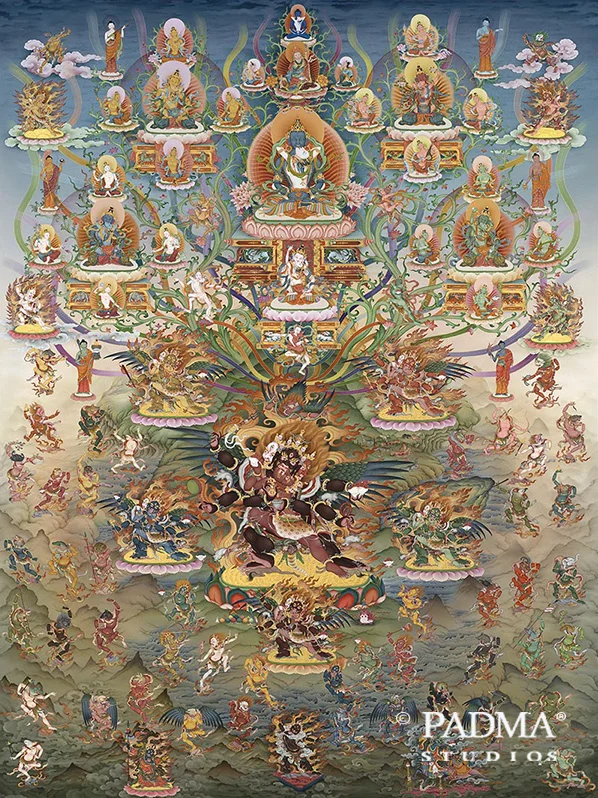Zhitro
Zhitro
Reproduction gicleé print by Pema Namdol Thaye
Natural pigments, precious stones & 24kt gold
Original size 40.5 x 54"
Completed 2018
Zhitro – which literally means "peaceful and wrathful" – refers to the forty-two peaceful and fifty-eight wrathful deities that were introduced by Guru Padmasambhava in the eighth century. These Buddhas are also known as the bardo deities. Bardo, which means "in-between-state", refers to one of six intermediate states, of which here we are specifically referring to the bardo of dying. This is the state between death and rebirth, wherein the one hundred Zhitro deities appear to the deceased in order to help liberate them from the bardo.
Guru Padmasambhava's Zhitro teachings create a direct pathway for us to connect with the bardo deities through practice and supplication, as a blessing in our life, as well as a direct preparation for liberation in the bardo after our death. According to the Bardo Thodrol, a definitive bardo text in Vajrayana Buddhism (commonly known in the West as The Tibetan Book of the Dead), bardo deities appear to the deceased for forty-nine days while the deceased is in the bardo. First the peaceful deities appear, and if one does not recognize and become liberated through the peaceful deities, then the wrathful deities manifest. If the deceased has not been able to connect with the deities during this forty-nine day period, then the consciousness is drawn back into rebirth within the six realms.
Becoming visually familiar with Zhitro deities provides tremendous benefit for practitioners who wish to achieve liberation in the bardo. This Chae-Thu style Zhitro thanka was painted by Pema Namdol Thaye in the traditional method of using hand-ground earth pigments and semi-precious stones, and 24kt gold. The painting, having taken more than twelve months of intense focus to complete, encompasses all one hundred peaceful and wrathful deities, as well as Guru Padmasambhava, Mandarava, Yeshe Tsogyal, the Five Vidyadharas, and three protectors: Ekajati, Mahakala Ma-Ning, and Shing Chong Sing Dong.
The painting's composition and detail is informed by the artist's twenty-five plus years of studying, painting, and sculpting Zhitro deities as taught to him by his master, the late Nyingma Abbot and artist, Venerable Lama Gonpo Tenzing Rinpoche. Exacting detail of each deity's iconography, including the unique emblems, colors, and identifying features, follow the Karling Shi-Tro text, and correspond with personal instructions given to the artist by Lama Gonpo Rinpoche and Kyabje Chatral Rinpoche.

